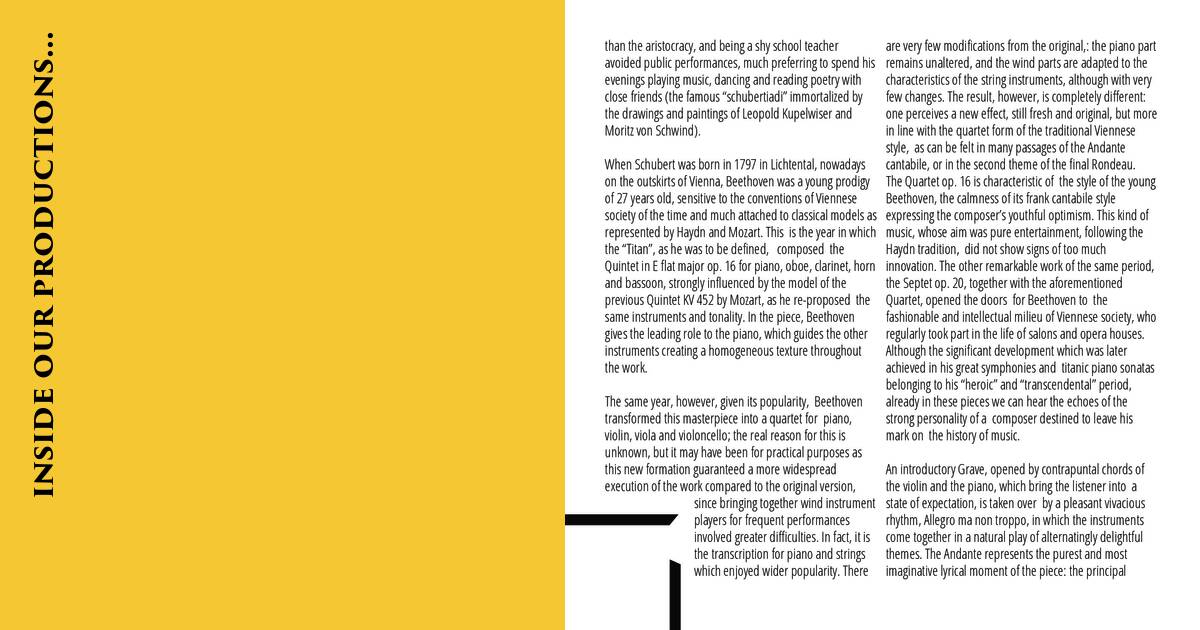
..an excerpt from a booklet from one of our publications... 0045
than the aristocracy, and being a shy school teacher
avoided public performances, much preferring to spend his
evenings playing music, dancing and reading poetry with
close friends (the famous “schubertiadi” immortalized by
the drawings and paintings of Leopold Kupelwiser and
Moritz von Schwind).
are very few modifications from the original,: the piano part
remains unaltered, and the wind parts are adapted to the
characteristics of the string instruments, although with very
few changes. The result, however, is completely different:
one perceives a new effect, still fresh and original, but more
in line with the quartet form of the traditional Viennese
style, as can be felt in many passages of the Andante
When Schubert was born in 1797 in Lichtental, nowadays cantabile, or in the second theme of the final Rondeau.
on the outskirts of Vienna, Beethoven was a young prodigy The Quartet op. 16 is characteristic of the style of the young
of 27 years old, sensitive to the conventions of Viennese
Beethoven, the calmness of its frank cantabile style
society of the time and much attached to classical models as expressing the composer’s youthful optimism. This kind of
represented by Haydn and Mozart. This is the year in which music, whose aim was pure entertainment, following the
the “Titan”, as he was to be defined, composed the
Haydn tradition, did not show signs of too much
Quintet in E flat major op. 16 for piano, oboe, clarinet, horn innovation. The other remarkable work of the same period,
and bassoon, strongly influenced by the model of the
the Septet op. 20, together with the aforementioned
previous Quintet KV 452 by Mozart, as he re-proposed the Quartet, opened the doors for Beethoven to the
same instruments and tonality. In the piece, Beethoven
fashionable and intellectual milieu of Viennese society, who
gives the leading role to the piano, which guides the other regularly took part in the life of salons and opera houses.
instruments creating a homogeneous texture throughout
Although the significant development which was later
the work.
achieved in his great symphonies and titanic piano sonatas
belonging to his “heroic” and “transcendental” period,
The same year, however, given its popularity, Beethoven
already in these pieces we can hear the echoes of the
transformed this masterpiece into a quartet for piano,
strong personality of a composer destined to leave his
violin, viola and violoncello; the real reason for this is
mark on the history of music.
unknown, but it may have been for practical purposes as
this new formation guaranteed a more widespread
An introductory Grave, opened by contrapuntal chords of
execution of the work compared to the original version,
the violin and the piano, which bring the listener into a
since bringing together wind instrument state of expectation, is taken over by a pleasant vivacious
players for frequent performances
rhythm, Allegro ma non troppo, in which the instruments
involved greater difficulties. In fact, it is come together in a natural play of alternatingly delightful
the transcription for piano and strings themes. The Andante represents the purest and most
which enjoyed wider popularity. There imaginative lyrical moment of the piece: the principal
News,Extra


